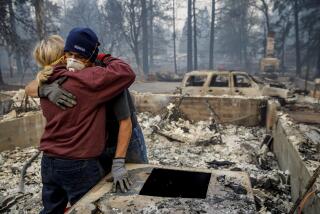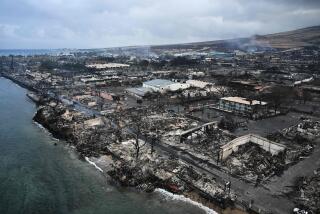Investigations into wildfire fatalities an uneasy process
As investigators swarm the former gold-mining town of Yarnell, Ariz., to examine the fateful decisions leading up to the deaths of 19 firefighters from the Granite Mountain hotshots, their presence is unlikely to ease tensions among the survivors.
More than a decade ago, a similar blaze whipped through a canyon 30 miles north of Winthrop, Wash. Four firefighters died in circumstances eerily similar to those at Yarnell, killed in their emergency shelters as a fast-moving fire burned over them.
By the time investigators had finished their work, a unit commander was facing federal criminal charges and supervisors in firehouses across the country found themselves on the hunt for liability insurance. The next time federal investigators began such an inquiry, firefighters started lawyering up.
Nobody seems happy with the outcome of the exhaustive, years-long investigation into that blaze, known as the Thirtymile fire. Firefighters call the investigation a witch hunt that unfairly sought to hold humans accountable for acts of nature, and they have resisted some new rules added after tragedies. Politicians and regulators who demanded firefighters change their ways and take greater precautions have been frustrated by what they see as excessive risk-taking and stubbornness.
Safety investigators and prosecutors, using legal tools honed in industrial accidents and airplane crashes, have had difficulty adapting their approach to the very different context of a fire line. Pinpointing how or when a detour from textbook operating rules led to a fatality has proven difficult. Winning and keeping the trust of the men and women in the fire camps has, if anything, proven even harder.
The Thirtymile fire and its aftermath provided a sobering view of how easy it is to make poor decisions amid the real-world demands of battling a wildfire.
The firefighters that headed out to suppress the flames in Chewuch Canyon on the morning of July 10, 2001, were not expecting much. The team’s job was to put out small spot fires. Attention was focused on a larger blaze to the south. A fire management officer at the Okanogan National Forest called the canyon operation “basically a mop-up show.”
Ellreese Daniels, a crew boss trainee, led the firefighters across the river to begin digging a fire line. A series of mishaps followed: The pumps did not work properly. Pulaskis, the axes used in fighting wildfires, began to break. Hoses burst.
The weather turned hot. Humidity plunged. Flames began reaching lengths of 8 feet, crossing containment lines and torching trees. Dense roots made digging a fire line untenable.
A fire that was estimated at just a few acres at mid-morning had grown to 50 acres by midafternoon. About 3:30 p.m., the blaze, pushed by strong winds and fueled by dense, dry vegetation on steep slopes, had doubled.
A couple of fresh fire engines arrived to fight spot fires up the canyon. Some of Daniels’ crew headed out to join them. Quickly, the futility of that effort became clear. Everyone was ordered out.
But for Daniels and 13 other firefighters, there was no exit. As Daniels began driving them down the road toward what he thought would be safety, he saw a “wall of flames.” All escape routes had been cut off.
The crew drove a mile up the canyon to a site where they thought they could wait safely as the fire passed them by. Instead, it made an abrupt lurch toward them. Survivors recalled flames “coming very fast, roaring” at them and with burning embers showering them in a “fire snowstorm.”
They scurried to unfold shelters as flames engulfed the site. One firefighter grew alarmed that his shelter would not hold together, so he ran down the slope and jumped in the river. Another jumped out of his and ran to safety in the crew’s van.
Four firefighters who had propped their shelters on a rocky hilltop died.
The details emerged in an exhaustive report put together under the direction of Allen Chockie, an investigator hired under contract by the U.S. Forest Service. Chockie found a litany of problems: Standard safety procedures were violated. Risks were not appropriately assessed. Rest rules were disregarded.
“People were very forthcoming with us,” Chockie said. “They were straight up about answering our questions and providing input.… We wanted to provide a foundation to avoid this situation from happening again.”
What came next surprised Chockie. His report became a foundation for criminal charges against Daniels.
In December 2006, federal prosecutors charged Daniels with involuntary manslaughter. They accused him of not taking proper precautions to protect his team. They also said he had made false statements to investigators.
“There was this need to hold somebody accountable,” Chockie said. “I couldn’t really understand it. A lot of poor decisions had been made by many people up and down the chain during this fire. But people wanted a simple answer.”
Colleagues rallied around Daniels, who ultimately pleaded guilty to making false statements and spent 90 days in work release. Manslaughter charges were dropped.
Just the year before, the U.S. attorney’s office in Boise, Idaho, had explored manslaughter charges against a commander for failing to post lookouts and monitor the safety of two firefighters who rappelled from a helicopter to fight the Cramer fire in the Salmon-Challis National Forest in 2003.
That commander was forced from his job and accepted a deal with prosecutors under which he was sentenced to probation.
When federal investigators later showed up in California to look into the 2006 Esperanza fire, near Cabazon, firefighters refused to talk to investigators without union officials present, and some sought advice of lawyers.
Firefighters across the country began seeking legal counsel instead of participating in investigations into fatalities, according to congressional testimony in 2007 from Mark Rey, then an undersecretary of the Department of Agriculture who oversaw the Forest Service.
“Many of our firefighters do not want to speak freely,” he said at the time. They were also opting not to take supervisory jobs for fear of being held liable, he said.
Chockie is not surprised. “When I saw what followed after our report, I can understand why people might be much more hesitant or cautious now,” he said. “What they told us came back to them in unexpected ways.”
Firefighter advocacy groups say investigators have been able to work more cooperatively with fire crews in recent years as prosecutors have backed away from pushing criminal charges. But, they add, they expect the extent of the Arizona tragedy will create pressure to hold individuals accountable.
“You are going to have families of fallen firefighters who want answers,” said Casey Judd, president of the Federal Wildland Fire Service Assn., an advocacy group for firefighters. “The answers you give them may not sit well.”
Times staff writer Julie Cart in Los Angeles contributed to this report.
More to Read
Start your day right
Sign up for Essential California for news, features and recommendations from the L.A. Times and beyond in your inbox six days a week.
You may occasionally receive promotional content from the Los Angeles Times.







